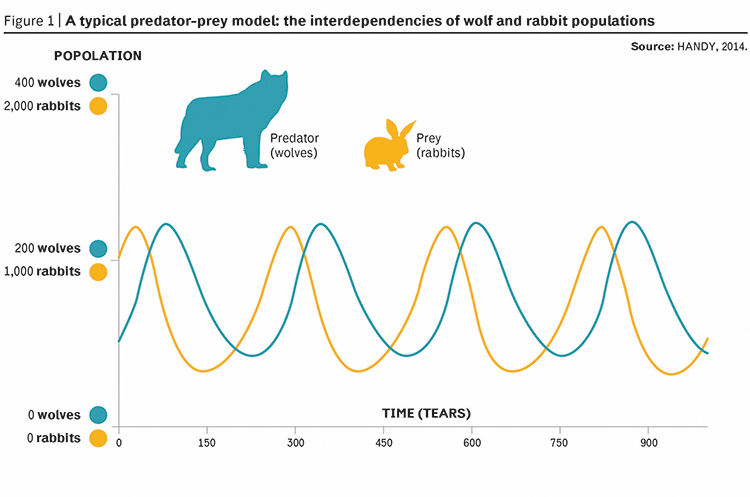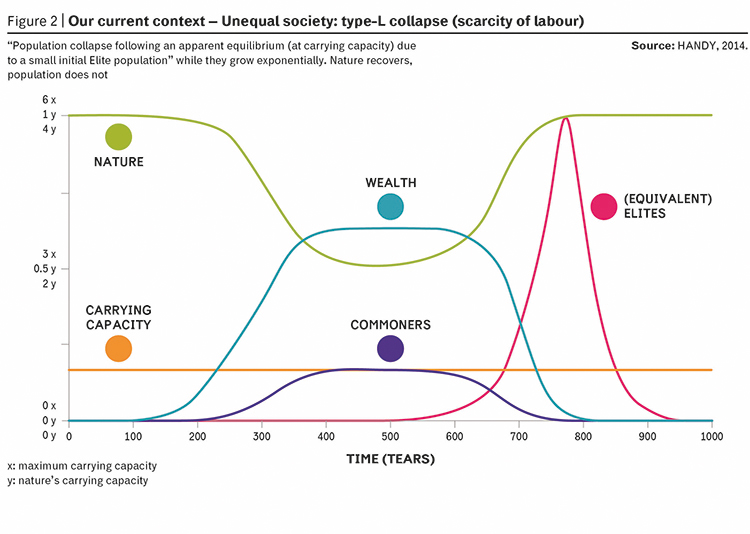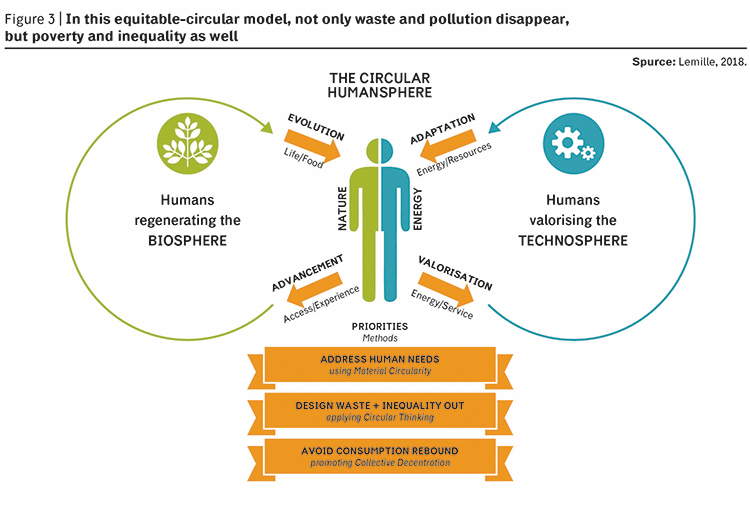We have the opportunity to change the course of our shared history with the amount of information we have gathered so far. By learning from scientists and experts we can propose new governance and collaboratively implement net-positive actions to adapt more quickly.
Knowing the specific origins of a potential collapse is our best way to avoid it.
Humans as Predators, Nature as Prey
Since its publication in 1972 “The Limits to Growth” has been one of the benchmarks for modelling the exponential economic and demographic growth of a finite planet. The 30-years update has once again confirmed that 1972 forecasts were not only accurate, but actually underestimated the reality. A more recent projection model with a broader spectrum of scenarios has also been published recently: the Human And Nature Dynamics (HANDY) model (Motesharrei, Rivas, Kalnay, 2014). This model of human dynamics is based on the predator-prey approach where we are the predators, and the prey is Nature (exhausted by humans).
The predator-prey approach comes from the animal kingdom when the predator population exceeds the carrying capacity (maximum size of the population of a species that the environment can sustain indefinitely). This leads to starvation or the migration of predators until the prey population recovers.
This model may well be related to our human world, except that we humans are able to accumulate large surplus stocks (described below as “wealth”). Stocks which we can draw on when production no longer covers our consumption needs. For example, we are currently bypassing the carrying capacity of the Earth (we consume 80 billion tonnes of materials from the Earth while it can only afford 50 billion), as our population continues to grow exponentially.

Economic Stratification and Wealth Accumulation
HANDY differs from previous models in its greater variety of scenarios (scenario 1: Egalitarian Societies, scenario 2: Equitable Societies and scenario 3: Unequal Societies) and by adding key indicators such as:
- economic stratification, “Elites” (rich population) and “Commoners” (poor population) and their corresponding consumption patterns;
- the accumulation of wealth (what we just described as our ability to create surplus stocks).
Understanding the impact of these two components – which have had negative repercussions in earlier civilizations such as the ancient Maya – is essential to understanding how we should maneuver today between inventory management, consumption patterns and, more importantly, ethical and fair access to stocks.
In the projections for egalitarian societies, the balance can be reached slowly when the Commoners do not exceed the carrying capacity of the Earth. Living well at equilibrium shows similar result in equitable societies where growth is slow and salaries equitable. But, when the depletion of resources exceeds a certain limit, nature collapses completely in the three possible scenarios: egalitarian, equitable and unequal societies. Consuming beyond carrying capacity leads to the depletion of Nature, as in the case of Easter Island. This is called the Type-N collapse (exhaustion of Nature). Here, the research highlights that we have not yet reached this point.
The Disappearance of Commoners
The set-up that comes closest to our global situation is not the collapse of nature. We all know now that the Earth will continue its path of recovering from all forms of long-term exhaustion, outside of any human-related time horizon. The risk we face today is the disappearance of labour represented here by Commoners. This is called the Type-L Collapse (scarcity of labour).
In unequal societies (for more information, please refer to the “Elephant graph of inequality”, www.wid.world), the strengthening of the economic stratification between classes of society is “recurrently found in past collapse societies” according to the researchers. They add that “the solution (here shown in the Figure 2) appears to be on a sustainable path for quite a long time, but even using an optimal depletion rate and starting with a very small number of Elites, the Elites eventually cause the collapse of society.”
In summary, the risk we face is more (current) mismanagement of resources due to inequitable consumption and limited access, in addition to climate change adaptation and mitigation.

Elites Are Not in a Visionary Position
In the research it is clearly established that “Elites – due to their wealth (i.e. access and control over surpluses) – do not suffer the detrimental effects of the environmental collapse until much later than the Commoners” (HANDY, 2014). They add that “this buffer of wealth allows Elites to continue ‘business as usual’ despite the impeding catastrophe.”
As in all societal organisations, we ask leaders to be visionary in order to give people access to a more prosperous future. It is possible to achieve an equilibrium that would prevent such collapse since we have enough data to drive the world’s population towards such a pathway:
- considerably reduce inequalities (here translated by the widening of the economic stratification between Commoners and Elites in Figure 2);
- reducing the growth rates of the population.
However, what comes as a matter of course is that Elites who benefit from surpluses and control access of the stock cannot be decision-makers at the same time. It would seem that “historical collapses were allowed to occur by Elites who appear to be oblivious to the catastrophic trajectory” (HANDY, 2014), a situation that is applicable to the Roman Empire and the ancient Maya civilizations. Worse still, Elites also collapse due to the disappearance of Commoners.
It is now clear that we need a different type of governance than the current one. Those with access to surpluses are not the ones best placed to lead our common future. Governance for the future of human civilization should rather be led by a group facing a higher risk of extinction. We should therefore be much more inspired by what the ancestral tribes tell us about their survival techniques in a hostile environment, rather than plundering their know-how and resources for commercial gains. Following their precepts should be an obligation in our future governance.
Equitable Circular Economies Focusing on the Prosperity of Society
With such a model of human dynamics, we have our fate in our hands because a Type-L collapse is preventable. However, it is clear that we must take drastic decisions in the way we govern our societies and in the evolution of policies.
The circular economy is an excellent solution to resource mismanagement: we manage resource stocks and renewable energy flows in a virtuous approach. The circular economy mimics Nature in as much as unused resources constitute food for another cycle. However, citizens and communities need more than a better way to manage resources as tomorrow’s business model. They need the assurance that we emerge from an unequal linear world by entering a prosperous and equitable one, aligned with the regeneration of our natural ecosystem that we depend on for life. In a circular context of resource conservation, caring for people will also be “good news” for business prosperity as business models will be based on the rules of system regeneration and enhanced collaboration.
A results-based economy becomes extremely versatile to meet all social needs, provided results also integrate them into their search for total performance. Since you will be rewarded if you have met the needs of the people in your communities and markets, the more your business will ensure all needs are treated with kindness, the better. Taking care of people and resources is possible when your product disappears behind the offer of a holistic caring experience (caring for stock and for people). In addition, such a results-based economy should provide Commoners with restorative jobs and regenerative activities that implement collaborative strategies.
Lastly, an equitable-circular model should also be governed by diverse communities that understand how to make decisions today that will protect future generations. This decision making process, which has always existed, is called “decentration” or the ability to decide whether unborn generations will agree with any given decision or not (shown in Figure 3 as the third priority to focus on). Decentration has helped minorities survive in unpromising contexts, as in the case of the Iroquois tribes among others. This should be taught to us all, starting with the Elites.
Reaching an equilibrium with Earth’s carrying capacity is the only decision we are indebted to take today.

Safa Motesharreia, Jorge Rivasb, Eugenia Kalnayc, “Human and nature dynamics (HANDY): Modeling inequality and use of resources in the collapse or sustainability of societies”, Ecological Economics v. 101, May 2014, p. 90-102; https://doi.org/10.1016/j.ecolecon.2014.02.014
World inequality database, www.wid.world
Circular Economy 2.0, www.AlexandreLemille.com


